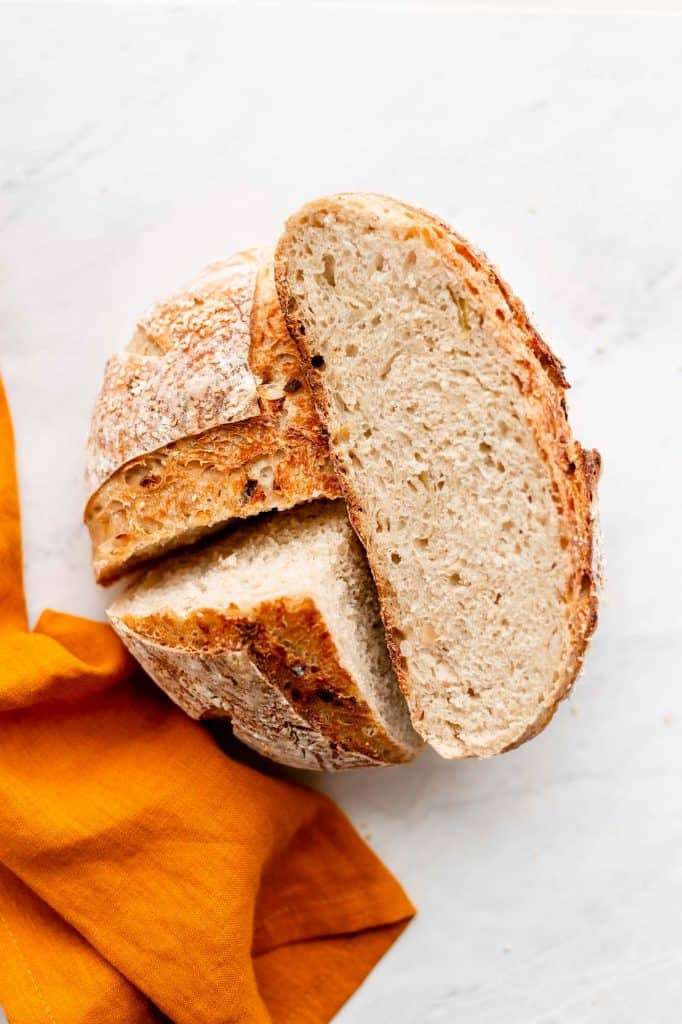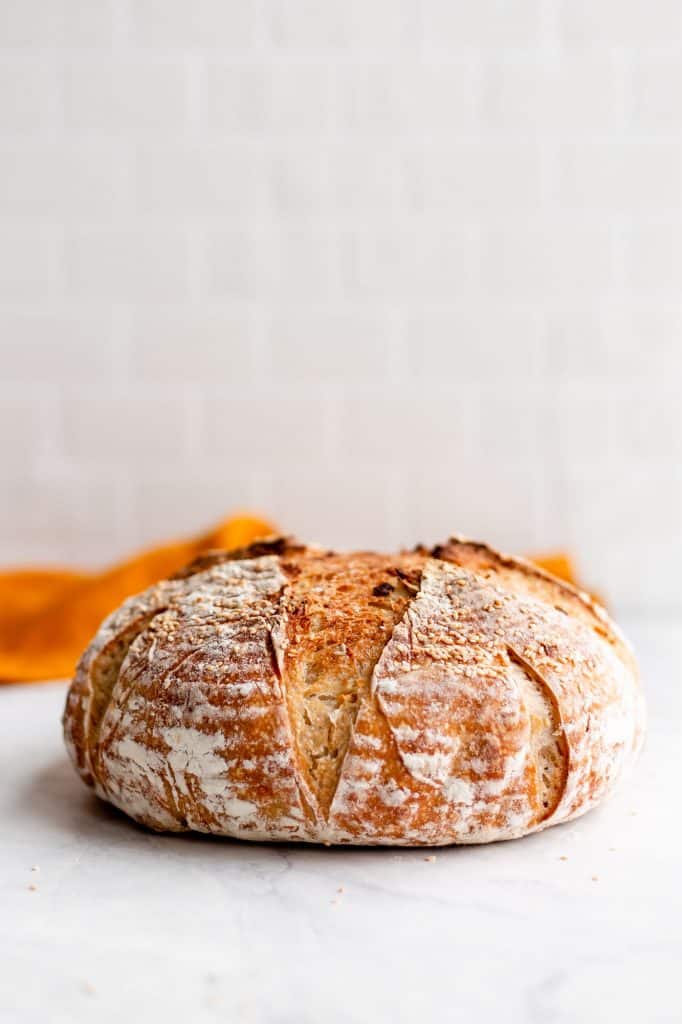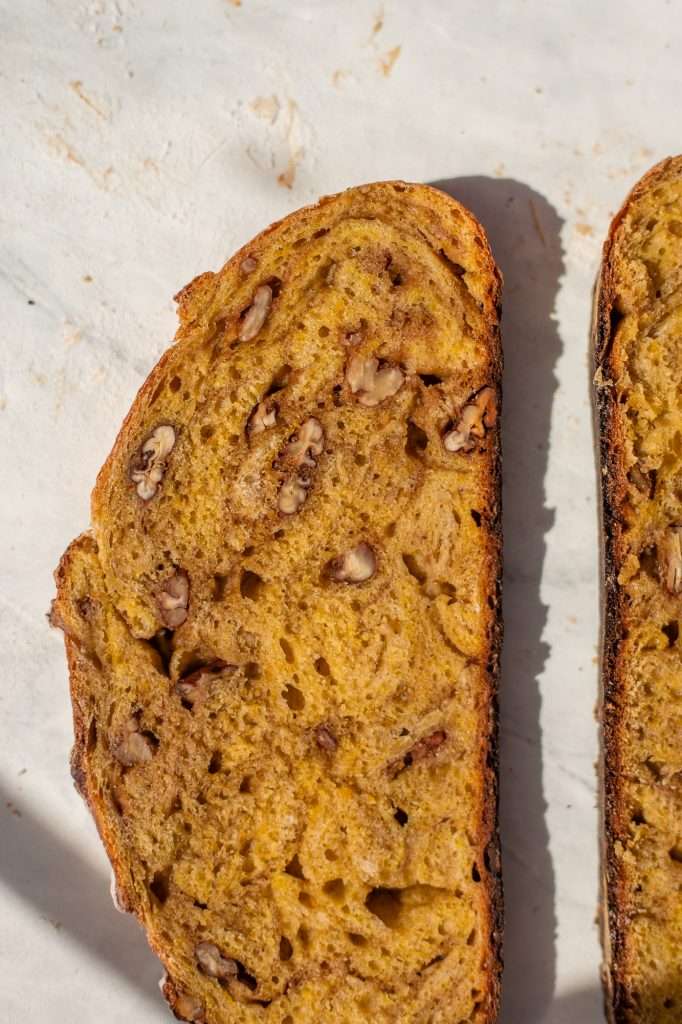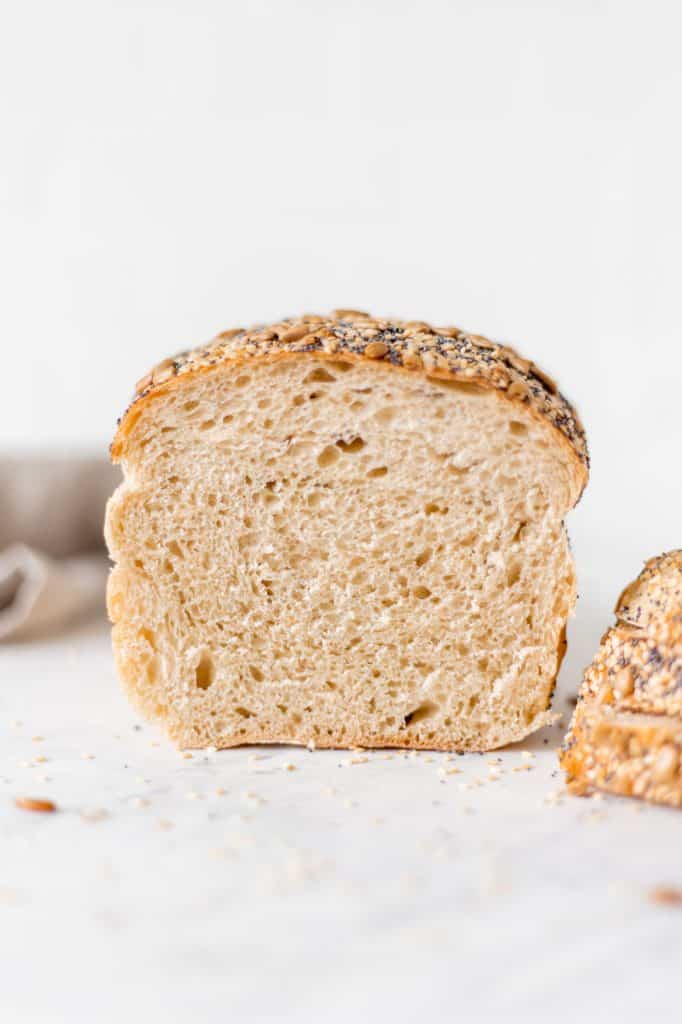This no-knead sauerkraut bread with is made with onion and sourdough starter for the most amazing savory bread flavor! You just need a few ingredients and an active sourdough starter to make this delicious sauerkraut onion bread.
An Easy Recipe with Sauerkraut
This sourdough bread recipe is the best way to cook with sauerkraut. I always get the question “does it kill the good bacteria when you cook the kraut?” Well, yes. However, Jon and I have so many fermented vegetables in our fridge, we like to eat them raw and cooked! Cooking sauerkraut at high temperatures kills the beneficial bacteria, but the flavor is amazing, and even cooked it still contains the other beneficial compounds found in fermented foods.
Since we recipe develop a lot of fermentation recipes, sometimes I end up with old kraut in the back of my fridge. It’s always still good and preserved, but sometimes it gets soft the longer it is stored. When this happens, my favorite thing to do is to throw the kraut into this sauerkraut and onion sourdough bread.

Sauerkraut Bread with Sourdough Starter
For any sourdough recipe, you need a sourdough starter. Just click here to learn How to Make a Sprouted Rye Sourdough Starter. My sprouted rye starter is my favorite, and I think the microbes in my starter are the most diverse and active when I feed them rye flour. I also have a recipe for an Easy Sourdough Starter Recipe with Sourdough Starter Feeding Instructions.
If you have any troubles or problems with your starter check out this blog: The Most Common Sourdough Starter Problems and How to Fix Them.

How to Make No-Knead Sauerkraut Bread
This is a no-knead sourdough bread recipe, so all you have to do is get the ingredients just combined. Then you stretch and fold over the dough a couple times during the rise period, shape the dough and bake. It’s very simple.
I’ve found that most sourdough breads can be no-knead. As long as you get all the ingredients just combined, have patience, and do a couple stretch and folds with wet hands, the bread will smooth out as it rises.

Onion Bread with Sauerkraut
- This seems a little obvious but have patience. You don’t want to end up baking an under-proofed loaf. If it’s cold in your house, it may take a while longer to rise. If it’s warmer in your house, the rise time maybe a little faster.
- Do not get lazy with the stretch and folds and the shaping steps in the recipe. These steps build up the gluten so that the loaf holds its shape during the long rise times.
- Proof overnight in the fridge before baking. This allows a nice crust to form on the sourdough, so when you score the bread it will develop “ears” and a beautiful crust after baking.
- Bake at a high temperature. I bake most of my sourdough loaves at 450° F.
- Bake sourdough loaves in a cast iron dutch oven. I used to bake my loaves on just a sheet pan, and when I switched to a dutch oven, the rise and crust on my loaves improved so much! To bake in a dutch oven, you have to preheat it with the oven, bake for 30 minutes with the lid on, and then about 30 minutes with the lid off.

Other Sourdough Bread Flavor Ideas
- The Best Maple Pecan and Cinnamon Sourdough Bread Recipe
- Sun-Dried Tomato and Herb Sourdough Bagels
- Dutch Oven Sourdough Boule Recipe

No-Knead Sauerkraut Bread with Onion and Sourdough Starter
This no-knead sauerkraut bread with is made with onion and sourdough starter for the most amazing savory bread flavor! You just need a few ingredients and an active sourdough starter to make this delicious sauerkraut onion bread.
- Prep: 15 minutes
- Cook: 1 hour
- Total Time: 8 hours 15 minutes
Ingredients
- 480 Grams (4 Cups) Bread Flour
- 360 milliliters (1 1/2 Cups) Cool Water
- 100 grams Sourdough Starter
- 10 grams Sea Salt
- 3 tablespoons dried onion flakes
- 1/2 cup sauerkraut, drained and chopped
Instructions
- It’s best to start the sourdough process before 9 am so you have enough time. Please check the notes section of this recipe for tips.
- In a large bowl, combine all of the ingredients and mix with a fork until just combined. The dough should be together in one mass, but it will look shaggy and bumpy.
- Let the dough rest for an hour.
- Stretch and Fold 1: Using a spray bottle filled with water, mist your clean countertop. Wet your hands and wet the top of the dough ball with the spray bottle. Turn the dough out onto the wet counter surface. Scrape out the bowl and rinse the inside of the bowl really well. Leave the bowl wet.
- Stretch and fold the dough. Stretch the top of the dough over the bottom, side over side, and bottom over top. Place the dough back in the bowl with the seam side down. Let the dough rest for 2 hours.
- Stretch and Fold 2: Using a spray bottle filled with water, mist your clean countertop again. Wet your hands and wet the top of the dough ball with the spray bottle. Turn the dough out onto the wet counter surface. Scrape out the bowl and rinse the inside of the bowl really well. Leave the bowl wet.
- Stretch and fold the dough. Stretch the top of the dough over the bottom, side over side, and bottom over top. Place the dough back in the bowl with the seam side down. Let the dough rest for 2 hours.
- Stretch and Fold 3: Using a spray bottle filled with water, mist your clean countertop again. Wet your hands and wet the top of the dough ball with the spray bottle. Turn the dough out onto the wet counter surface. Scrape out the bowl and rinse the inside of the bowl really well. Leave the bowl wet.
- Stretch and fold the dough. Stretch the top of the dough over the bottom, side over side, and bottom over top. Place the dough back in the bowl with the seam side down. Let the dough rest for 2 hours.
- Clean and dry the counter surface you’re working on. Sprinkle some flour on the surface of your counter and coat your hands in a bit of flour.
- Sprinkle flour on the top of the dough ball. Gently flip the dough out onto the floured surface so that it is seam side up, floured side down.
- Pre-shape: Gently stretch out the dough, and fold it again. Fold side over side and top over bottom. Then flip the dough over so that the seam side is down on the counter. Tuck under any parts of the dough you need to form a nice circular shape. Leave the dough on the counter, sprinkle some flour on the top of the dough, and cover with a clean towel.
- Let the dough rest for 1 hour.
- Final Shape: Sprinkle a little more flour on the top of your pre-shaped dough and on the counter around the dough. With your hands coated in flour, flip the dough over so that the seam side is up again.
- Gently stretch out the dough, and fold it again. Fold side over side and top over bottom. Then flip the dough over so that the seam side is down on the counter. Tuck under any parts of the dough you need to form a nice circular loaf shape. This is the final shaping so take your time with it.
- Coat a proofing basket with flour. Be generous, as you do not want it to stick. You can also use a bowl lined with a towel and a generous amount of flour.
- Flour your hands and swiftly pick up and flip your dough into the basket. Smooth side down, seam side up.
- Cover and place in the fridge overnight for 8-12 hours.
- After 8-12 hours in the fridge, preheat your dutch oven with the lid, in your oven at 450° F. (see notes on temperature)
- Once your oven is preheated, carefully remove your dutch oven and place the lid to the side. *Don’t forget that the pot and the lid are both very hot!*
- Cut a large square of parchment paper and place it on the counter. Turn your dough out onto the paper so that the seam side is down and touching the parchment paper.
- Score the dough using a very sharp knife or a scoring tool.
- Picking up all four corners of the parchment paper, move your dough into the dutch oven.
- Place the lid on the dutch oven and bake at 450° F for 30 minutes.
- After baking covered, remove the lid and bake for another 30 minutes at 450° F.
- Remove your finished loaf from the dutch oven and allow it to cool for at least 1 hour.
Notes
- The time you need to wait in between stretch and folds depends on the temperature in your house. If your house is above 75° F, you may be able to reduce the amount of time between stretch and folds to one hour.
- You can also speed up the time in between stretch and folds by using a bread proofer or heating pad near the dough. Just stretch and fold when the dough has risen a bit and relaxes out into the bottom of the bowl, and make sure you do at least three stretches and folds. Monitor the dough to make sure you do not over-proof.
- when flouring your proofing basket, it helps to use coarse flour such as rye, cornflour, or rice flour.
- Depending on your oven, you can bake at a lower temperature. Some ovens run hotter than others.
- When baking with the dutch oven lid off, check every few minutes. Some ovens run hotter than others, so check to see when the loaf is golden brown.





















Have you ever substituted rye flour for some of the bread flour? I think this would be a great bread for Reuben sandwiches and would like more rye flavor. Thank you.
I have, and it works well! Just substitute up to 1/3 of the bread flour with rye flour.
Tried this recipe. Turned out great! Next time I will add caraway seeds and rye flour as suggested.